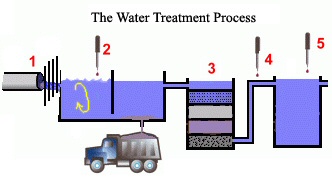Treatment Process
The two main types of water sourced in Co Longford are:
- Underground Water (from a well)
- Surface Water (from rivers & lakes)
In order to ensure that the supplies of drinking water are clean, Longford County Council has treatment plants that treat the water according to its source. The methods of treating water are described below.
Surface Water
There are five stages in the treatment of water taken from our lakes & rivers:

Screening: Water is passed through a fine wire mesh to remove debris, such as twigs, plants, etc.
Settling: Once screened the water is moved into large settling/sedimentation tanks. Whilst in the sedimentation tank the water is treated with a chemical known as Alum (aluminium sulphate) to remove any cloudiness or discolouration.
Filtration: Then the water is passed through filtration beds made up of sand and gravel to ensure that even the smallest dirt particles are removed. this is often referred to as the "polishing effect".
Chlorination: Once filtration is complete the water is disinfected by treating with Chlorine. Enough chlorine is added to kill the bacteria present at that time and to prevent re-infection as it travels along the pipeline. The chlorine should not be present in large enough quantities to smell or taste in the water.
Fluoridation: All public water supplies are treated by adding small quantities of compounds such as sodium fluoride to the water. Fluoride is added as an aid to prevent tooth decay and at the behest of the relevant health boards.
The water is now ready and suitable for human consumption.
Underground Water
The treatment of water from underground sources is far simpler using only stages 1, 4 and 5 as described for the treatment of Surface water above. As the water travels from an underground source it has been naturally filtered by the time it reaches the surface, simply Screening, Chlorination and Fluoridation is enough to prepare it for our use.